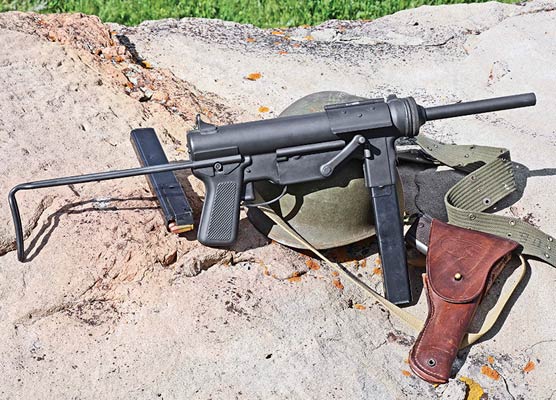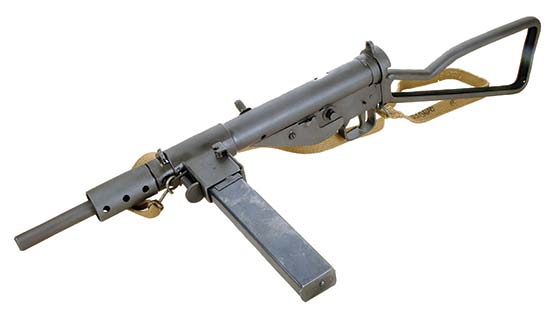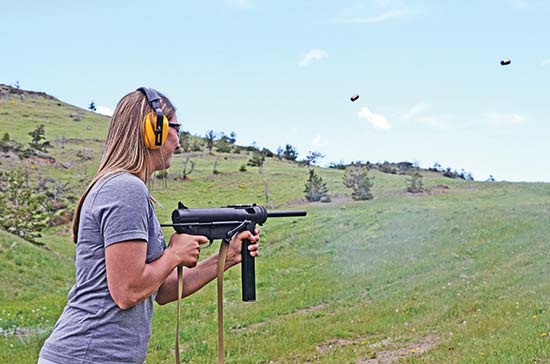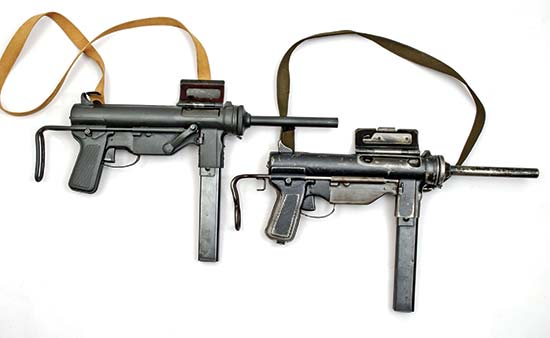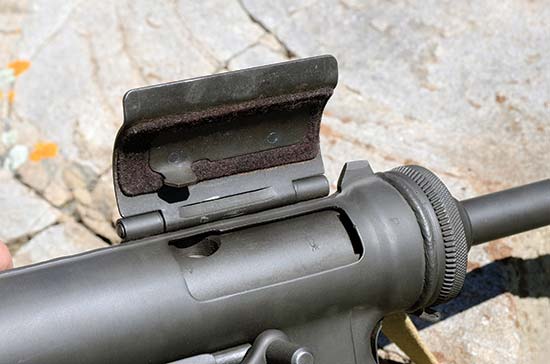The Grease Gun
Cheap, Utilitarian And Deadly …
Grease Gun! How does a military weapon get named for an automotive accessory you’d find in a service garage? Well, because it actually looks like one. In reality, it’s a nickname for two versions of the same World War II vintage .45 ACP submachine gun — the M3 and M3A1. Both versions were all metal, stamped and spot-welded together.
Weight And Cost
Contrary to its cult following, the U.S. Models 1928, 1928A1, M1 and M1A1 Thompson SMGs (collectively called Tommy Guns) were not the greatest design. They were heavy and expensive to manufacture.
My 1942-vintage M1 Tommy Gun weighs 11.25 lbs. with an empty 30-round magazine. A British MII Sten weighs 7.50 lbs. with a 32-round magazine, a German MP40 weighs 8.75 lbs. (also with a 32-round magazine) and an M3 Grease Gun weighs 8.75 lbs. with a 30-round magazine. These are actual weights of my own samples with slings attached.
As to ammo, a single round of 230-gr. .45 ACP hardball weighs 323 grains. A factory round of 9mm (115 grains) weighs 180 grains. Computing a bit further, 30 rounds of .45 ACP adds 1.43 lbs. to the SMG’s weight but 32 rounds of 9mm add only 0.82 lbs.
However, manufacturing costs might have been the most important factor for America wanting to discontinue purchases of Tommy Guns as early as 1942. At the beginning of World War II a Model 1928A1 cost the U.S. Government about $212. The alterations to make them into cheaper M1 and M1A1 reduced that to between $42 and $44.
However, a Grease Gun only set the government back about $22. Thus the M3 was adopted and production of Tommy Guns was stopped in 1944 after a total of about 1.5 million had been made in all the variations. (These rounded dollar figures are approximations because research sources disagree on exact figures.)
Filling A Niche
It’s appropriate to understand the purposes of SMGs as used in World War II and even what constitutes an SMG. The term refers to a handheld weapon firing pistol cartridges as opposed to machineguns, which normally were fired from tripods or bipods and fed full-size rifle cartridges.
Upon their introduction late in the First World War, the idea was to use SMGs as “Trench Brooms” as General John T. Thompson first called his new designs. Trenches were not so common in World War II, but by then SMGs had been given another assignment. They were issued to crews of armored vehicles for keeping enemy infantry from crawling aboard. The idea was tank crewmen could stick them out view slits or pop up in turrets to “sweep” enemies off their vehicle.
It’s worth noting the tanks America shipped overseas even to Allied nations such as Britain, France and even the Soviet Union first had Tommy Guns in their turrets. Later they became M3 or M3A1 Grease Guns. I’ve been told some National Guard tanks shipped to the Mideast for the Iraqi War of 1991 still contained Grease Guns.
M3s made their combat debut in World War II in the hands of some 82nd and 101st Airborne parachute infantry who dropped into Normandy in the D-Day invasion. By then SMG roles had increased. Most armies considered them a benefit in urban street-to-street and room-to-room fighting. In most American infantry units they were issued to NCOs, but parachute units often carried many more than regular infantry in an effort to boost their limited firepower.
Form And Function
It can be said the British Sten was partly responsible for the Grease Gun’s development. Officials from the Guide Lamp Division of General Motors studied the production methods used by the British when tooling up for M3 production. Stamped parts were used wherever possible and spot-welded whenever possible. Sometimes the crude production of Sten Guns caused them to be nicknamed “Plumbers’ Nightmares.” Likewise, the M3 never received the adulation given the Thompson.
The Grease Gun was of a simple blowback design firing from an open bolt. You pull the bolt back for the first shot and it stays back until you pull the trigger. The bullet’s passage up the barrel pushes the fired case rearward, in turn retracting the bolt. Then a spring pushes the bolt forward to pick up another cartridge and firing it — which it continues to do as long as the trigger is held back.
The rate of fire of such a system can be adjusted by the weight of the bolt. The M3 was nominally rated at 400-450 rounds per minute. Mine is almost consistently right at 400 RPM. In comparison, my M1 Thompson SMG is consistently around 700. By the adoption of the M3, designers realized semi-auto fire from an SMG was likely foolish. Personally, I’ve never read of an instance where one was used as a semi-auto in combat. Both the M3 and the later M3A1 was full-auto only. But a little practice — combined with the gun’s slow rate of fire — makes it easy to squeeze and release the trigger to fire a single shot.
Simplification
The military soon realized — even with M1 and M1A1 Thompsons — intricate adjustable rear sights were a waste on an SMG. A bent piece of steel with an aperture drilled through it sufficed. This bare-bones arrangement was carried over to Grease Guns. Also removed was a mechanical safety. Instead, a projection on the ejection port cover fitted into a recess in the bolt. This arrangement holds the bolt forward until the cover is flipped up. To make them extra handy in the confines of a vehicle, M3s and M3A1s were given a sliding metal-wire stock. With the stock extended the Grease Gun can be shoulder-fired. With it retracted it can be fired more or less like a two-fisted handgun.
One M3 feature not carried over to the M3A1 was the charging crank — basically a handle on the M3’s right side. Pulling it back cocks the bolt and readies the gun for firing. Early combat reports indicated the crank was fragile. In the heat of battle it was possible to damage it by “hard-cranking” and rough usage could break it off. Instead of a charging handle, the M3A1 featured a hole in the bolt for the user to insert his finger in to cock the gun. (If you watch the movie Fury starring Brad Pitt, note his tank crew carries M3A1s — not impossible since the movie is set in April 1945, but perhaps unlikely.)
As with the Tommy Guns, their replacement Grease Guns spawned many accessories — flared flash hiders, noise suppressors and even an experimental curved barrel for shooting around corners. One accessory package I would dearly love to have for my M3 is the conversion kit to make it a 9mm. All M3 and M3A1 SMGs used in World War II were produced by Guide Lamp. More M3A1s were made during the Korean War by Ithaca. The total produced was about half that of Tommy Guns.
Grease Guns are not as sought after by collectors as say, any version of Tommy Gun or German MP40. I was no different. It was the last SMG added to my own collection, but I’ve never regretted buying it.
